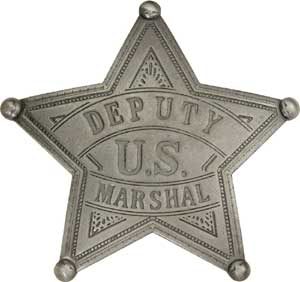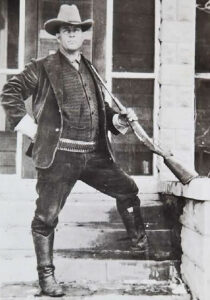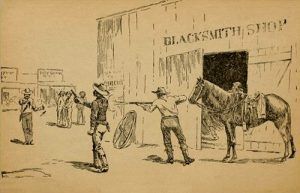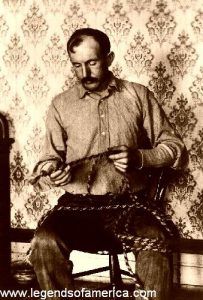Lawman Summaries (name begins with) A B C D E F G H I J K L M N O P Q R S T U V W X Y Z
Wiley G. Haines (1860-1928) – Undersheriff, County P, Oklahoma Territory; U.S. Deputy Marshal, Oklahoma Territory; Chief, Osage Indian Police.
Jesse Lee “Red” Hall (1849-1911) – Born in Lexington, North Carolina, on October 9, 1849, Hall headed westward as a young man and was living in Texas in 1869, where he began to work as a lawman, serving as a deputy sheriff in Denison and city marshal in Sherman. Later, he also joined the Texas Rangers under Captain L.H. McNelly. Serving from August 1876 to February 1880, he became a second lieutenant of the Special Forces of the Texas Rangers and earned a sterling reputation as a strong officer. Later, he was made captain, helped to break up the Sutton-Taylor Feud, and was instrumental in the arrest of John King Fisher. After leaving the Texas Rangers, Hall married, sired five daughters, and became a ranch manager. He also served as an Indian Agent for the Anadarko tribe. During the Spanish American War, he raised two companies of volunteers. He served in the Philippines as a leader of the Macabebe Scouts until he left the military service in October 1900. Hall died on March 17, 1911, and was buried at the National Cemetery in San Antonio, Texas.
Frank Hamer (1884-1955) – Captain Frank Hamer was a Texas Ranger and Lawman who led the posse that tracked down and killed notorious outlaws Bonnie Parker and Clyde Barrow in 1934.
Dee Harkey (1866-1948) – Cowboy, lawman, rancher, and gunfighter, Harkey was born in Richland Springs, Texas, on March 27, 1866. One of eight children, he was orphaned at the age of three and raised by an older brother. During his youth, he witnessed much violence, including Indian attacks, and three of his brothers were killed in gunfights. Harkey first began to make his way as a farmhand and a cowboy, but at the age of 16, he became a deputy under his brother, Joe, who had been elected sheriff of San Saba County, Texas. Four years later, Harkey married and established a farm in Bee County, Texas. There, he got into a conflict with a neighbor named George Young, and when the dispute escalated to a knife fight, Harkey killed him. In 1890, Harkey moved to Carlsbad, New Mexico, and was soon made a U.S. Deputy Marshal. Over the years, Harkey served as a lawman in New Mexico, holding various positions, including town marshal and Cattle Inspector. After he retired, he ranched in Eddy County until he died in his eighties.
James Harris – A gunman and former lawman, he was killed while dueling Bob Majors at Santa Cruz, California, in the 1880s.
Caleb “Loss” Lawson Hart (1862-1934) – Born in Park County, Texas, in 1862, Hart grew up to serve eleven years as a U.S. Deputy Marshal in Indian Territory. He killed the notorious Bill Dalton near Elk, Oklahoma, during this time. Two years later, he moved to McGee, Oklahoma, where he worked in merchandising. During this time, he barely survived a smallpox attack. He died on January 31, 1934, and was buried in McGee.
John Coffee “Jack” Hays (1817-1883) – A captain of the Texas Rangers, Hays fought in the Indian and the Mexican-American wars.
Jack Helm (1839-1873) – John Jackson “Jack” Helm was a Texas cowboy, Confederate soldier, gunfighter, and lawman. After becoming involved in the Sutton-Taylor Feud in DeWitt County, he was tracked down and killed by Jim Taylor and John Wesley Hardin in July 1873.
James Butler “Wild Bill” Hickok (1837-1876) – Marshal in Abilene and Hays City, Kansas. Better known as a gunfighter. Killed by Jack McCall in Deadwood, South Dakota, in 1876.
James Hicks – See Tom Horn
Fred R. Higgins – Commissioned as a U.S. Deputy Marshal in Arizona in the 1890s, Higgens and seven other posse men set out after Black Jack Christian’s High Fives Gang, who had attempted to rob the International Bank of Nogales, Arizona, on August 6, 1896. When the lawmen found their hideout in the San Simon Valley on November 18, 1896, a gunfight erupted, and splinters were showered into Higgins’ face. However, the lawman persevered returned the fire, and killed outlaw Bob Hayes. However, Black Jack Christian and two other outlaws escaped. Still on their tail the following April, they tracked the fugitives to a cave near Clifton, Arizona, yet another gunfight erupted. Christian was killed, but two others were able to flee. After the turn of the century, Higgins became the sheriff of Chaves County, New Mexico.
George W. Hindman (18??-1878) – Originally from Texas, where he worked as a cowboy, Hindman made his way to New Mexico in 1875. There, he hired on at a ranch owned by Robert Casey in Lincoln County. A few years later, he took a position as a deputy under Sheriff William Brady, just before the onset of the notorious Lincoln County War. On February 18, 1878, he rode in the posse that killed John Tunstall, which ignited the bloody feud. Some six weeks later, on April 1, 1878, while Sheriff Brady and Hindman were walking down Lincoln’s main street, they were ambushed by Billy the Kid and some of his cohorts. Both lawmen were killed.
Edward O. Hogue (1847-1877) – Born in France in 1847, Hogue immigrated to the United States, and in 1872, he became a policeman in Ellsworth, Kansas, and later served as city marshal. When the police force was terminated over the Whitney-Thompson affair, Hogue was left to make arrests on his own. However, in 1873, he lost the election for sheriff. Two years later, he worked as a deputy sheriff in Dodge City, Kansas. Afterward, he made his way to Wyoming, where he died at the age of 30.
John Henry “Doc” Holliday (1851-1887) – Deputized by Virgil Earp in Tombstone, Arizona, to help stop the crimes of the Clanton Gang, which culminated with a gunfight at the Gunfight at the O.K. Corral in October 1881. He died of tuberculosis in Colorado in 1887.
Cassius “Cash” M. Hollister (1845-1884) – Born near Cleveland, Ohio, Hollister made his way to Kansas in 1877 and was elected mayor of Caldwell, Kansas, on October 28, 1879, a position he held until April 1880. He was appointed a U.S. Deputy Marshal in 1883 and a few months later was involved in the Hunnewell Gunfight, in which one man was killed and another seriously wounded. On November 21`, 1883, he and Ben Wheeler killed a man named Chet Van Meter, who was resisting arrest. He resigned as a U.S. Deputy Marshal in September 1884 but continued to serve as a deputy sheriff of Sumner County, Kansas. On October 18, 1884, he went to arrest a man named Bob Cross, who was wanted for abducting the daughter of a well-to-do farmer, Joshua Hannum. When Hollister arrived at Cross’ home and attempted to talk the man out of the house, Cross refused to surrender. Hollister threatened to set his house on fire, at which time Cross fired through the door, killing Hollister.
William “Hunky Dory” Holmes (18??-1889) – A lawman, served as a deputy sheriff under Sheriff Glen Reynolds of Gila County, Arizona. He was murdered by the Apache Kid and his men while transporting the outlaw to the Yuma Prison.
Tom Horn, aka: James Hicks (1860-1903) – Horn joined the Pinkerton Agency in 1890 and was highly effective, tracking down dozens of outlaws. Later, he worked as a cattle detective in Wyoming and became embroiled in the Johnson County War. He also began offering his services as a hired gunslinger and was arrested and hanged on November 20, 1903.
Joe Horner – See Frank M. Canton
J. Edgar Hoover (1895-1972) – John Edgar Hoover, the first and longest Director of the Federal Bureau of Investigation, was a very powerful man who was not only lauded for building the FBI into a large and efficient crime-fighting agency, but he was also an extremely controversial figure due to his secret abuses of power, and rumors of homosexuality and cross-dressing.
James D. Houck (1846-1921) – James D. Houck was a miner, trader, pioneer, lawman, and namesake of Houck, Arizona. He was involved in the Pleasant Valley War with Commodore Perry Owens and helped establish the city of Cave Creek in Maricopa County.
Neil Howie (1834-1874) – Neil Howie was a territorial lawman in Montana who often worked with Montana Vigilantes to rid the territory of outlaws.
Thomas J. Hueston (18??-1893) – Appointed as a U.S. Deputy Marshal in Oklahoma Territory, Hueston was with other deputy marshals when they tracked down Doolin-Dalton Gang member Oliver Yantis, who had participated in Caney, Oklahoma train robbery and the Spearville, Kansas bank robbery in the fall of 1892. Trailing the fugitive to his sister’s ranch near Orlando, Oklahoma, a gunfight erupted when the fugitive resisted arrest, and Hueston shot and killed the outlaw. Later, however, when Hueston was still on the trail of the Doolin-Dalton Gang, he would not be so lucky. On September 1, 1893, Hueston was with a posse trying to capture several members hiding out in Ingalls, Oklahoma, when the famous Ingalls Gunbattle erupted. In the melee, Hueston was shot by “Arkansas Tom” Jones. Hueston died the following day. Two other fellow officers, Deputy Lafayette Shadley, and Dick Speed, were also killed in the shoot-out.
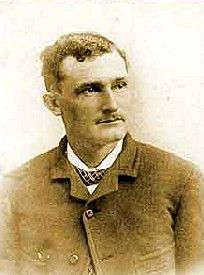
John R. Hughes
John Reynolds Hughes (1855-1947) – John Reynolds Hughes was a cowboy, rancher, author, and one of the most influential and recognized Texas Rangers during his lifetime. After Hughes had served as a Texas Ranger for 28 years, longer than any other man, he retired on January 31, 1915.
James B. Hume (1827-1904) – Hume was a miner, trader, and lawman in California after the Gold Rush began, but he left his mark on history as a Wells Fargo detective who captured stagecoach robbers such as Black Bart.
Alexander Cameron Hunt (1825-1894) – Born in New York on December 25, 1825, Hunt made his way west when he grew up, landing in Denver in 1859. In June 1862, he was appointed as a U.S. Marshal for the Colorado District. Hunt was later appointed the governor of Colorado by President Johnson in May 1867, a position he held until June 1869. He then began to work in the railroad industry and became interested in coal mines near Laredo, Texas. However, he continued to live in Denver. He died in Chicago, Illinois, on May 24, 1894.
J. Frank Hunt – (18??-1880) – Caldwell, Kansas deputy marshal, he was shot to death by an unidentified man on October 11, 1880.
I
Tom Irvan – Sheriff of Custer County, Montana, who gained a reputation as one of the state’s most famous manhunters.
Also See:
Adventures in the American West
Lawmen of the Old West (main page)
Lawman Summaries (name begins with) A B C D E F G H I J K L M N O P Q R S T U V W X Y Z

